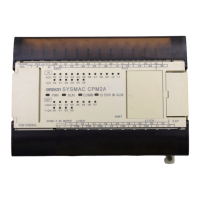1-1SectionCPM2A Features and Functions
4
The same Programming Devices, such as Programming Consoles and Support
Software, can be used for the C200H, C200HS, C200HX/HG/HE, CQM1,
CPM1, CPM1A, CPM2C, and SRM1 (-V2) PCs, so existing ladder program re-
sources can be used effectively.
Built-in Motor Control Capability
Synchronized pulse control provides an easy way to synchronize the operation
of a peripheral piece of equipment with the main equipment. The output pulse
frequency can be controlled as some multiple of the input pulse frequency, al-
lowing the speed of a peripheral piece of equipment (such as a supply conveyor)
to be synchronized with the speed of the main piece of equipment.
Encoder
CPM2A
Motor driver Motor
Pulses are output as a fixed multiple of the input frequency.
The CPM2A has a total of five high-speed counter inputs. The one high-speed
counter input has a response frequency of 20 kHz/5 kHz and the four interrupt
inputs (in counter mode) have a response frequency of 2 kHz.
The high-speed counter can be used in any one of the four input modes: differen-
tial phase mode (5 kHz), pulse plus direction input mode (20 kHz), up/down
pulse mode (20 kHz), or increment mode (20 kHz). Interrupts can be triggered
when the count matches a set value or falls within a specified range.
The interrupt inputs (counter mode) can be used for incrementing counters or
decrementing counters (2 kHz) and trigger an interrupt (executing the interrupt
program) when the count matches the target value.
CPM2A PCs with transistor outputs have two outputs that can produce 10 Hz to
10 kHz pulses (single-phase outputs).
When used as single-phase pulse outputs, there can be two outputs with a fre-
quency range of 10 Hz to 10 kHz with a fixed duty ratio or 0.1 to 999.9 Hz with a
variable duty ratio (0 to 100% duty ratio).
When used as pulse plus direction or up/down pulse outputs, there can be just
one output with a frequency range of 10 Hz to 10 kHz.
High-speed Input Capabilities for Machine Control
There are four inputs used for interrupt inputs (shared with quick-response in-
puts and interrupt inputs in counter mode) with a minimum input signal width of
50 µs and response time of 0.3 ms. When an interrupt input goes ON, the main
program is stopped and the interrupt program is executed.
There are four inputs used for quick-response inputs (shared with interrupt in-
puts and interrupt inputs in counter mode) that can reliably read input signals
with a signal width as short as 50 µs.
The input time constant for all inputs can be set to 1 ms, 2 ms, 3 ms, 5 ms,
10 ms, 20 ms, 40 ms, or 80 ms. The effects of chattering and external noise can
be reduced by increasing the input time constant.
Other Functions
The interval timer can be set between 0.5 and 319,968 ms and can be set to gen-
erate just one interrupt (one-shot mode) or periodic interrupts (scheduled inter-
rupt mode).
There are two controls on the CPU Unit that can be turned to change the analog
settings (0 to 200 BCD) in IR 250 and IR 251. These controls can be used to eas-
Share Programming
Devices
Synchronized Pulse
Control
(Transistor Outputs Only)
High-speed Counters and
Interrupts
Easy Position Control
with Pulse Outputs
(Transistor Outputs Only)
High-speed Interrupt
Input Function
Quick-response Input
Function
Stabilizing Input Filter
Function
Interval Timer Interrupts
Analog Settings

